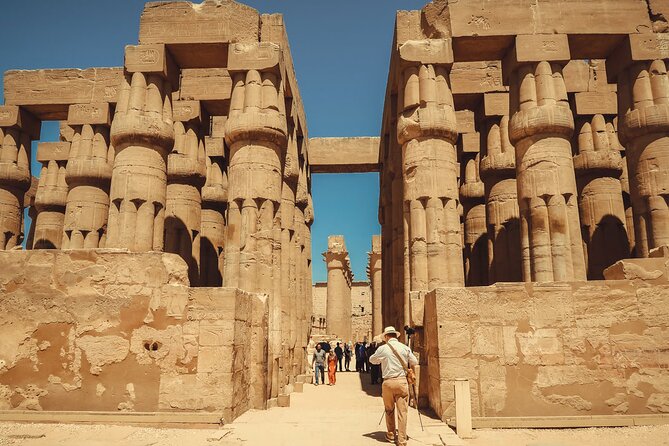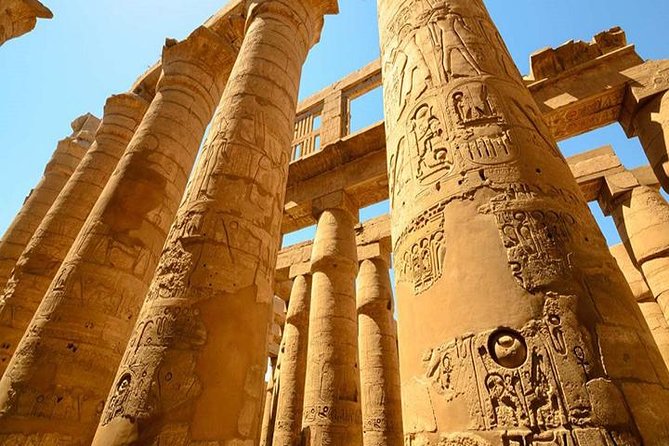Luxor East Bank, Karnak and Luxor Temples
Nestled in Luxor’s East Bank are the awe-inspiring temples of Karnak and Luxor, each holding secrets of ancient Egypt’s rich history and spirituality.
While many are familiar with the grandeur of these sites, few realize the hidden chambers and mysterious carvings that await curious explorers. Unraveling the enigmatic stories etched in stone, visitors are transported back in time to an era of pharaohs and gods, where every pillar and inscription whispers tales of a bygone civilization.
This journey through Luxor’s East Bank promises a captivating experience that will leave enthusiasts yearning to uncover more about these legendary temples.
Key Points
- Luxor’s East Bank boasts Karnak Temple and Luxor Temple, revealing Egypt’s history and spirituality.
- Egyptologist-led tours offer in-depth insights into religious practices and architectural wonders.
- Luxor Temple complex honors the Theban Triad with colossal statues and intricate hieroglyphics.
- Karnak Temple’s vast complex unravels ancient Egyptian history through hidden chambers and detailed carvings.
Here's some more nearby activities we've reviewed
Luxor East Bank Overview

Exploring Luxor’s East Bank reveals a captivating blend of ancient temples and archaeological wonders, offering visitors a profound insight into Egypt’s rich history and religious significance. The Luxor East Bank is home to the magnificent Karnak Temple and the impressive Luxor Temple complex.
Karnak Temple, dedicated to the god Amun, is a vast open-air museum that showcases the evolution of ancient Egyptian religious beliefs and practices. On the other hand, Luxor Temple, built by Amenhotep III and Ramses II, represents the political and religious center of Thebes during the New Kingdom.
The intricate carvings, massive columns, and grand courtyards in both temples provide a fascinating glimpse into the religious and historical significance of ancient Egypt.
Egyptologist-led Guided Tour Details

Set out on an enlightening journey through Luxor’s East Bank led by a knowledgeable Egyptologist, delving into the ancient mysteries of Karnak Temple and the Luxor Temple complex. As you explore these historical sites, you’ll discover:
-
Exploration Techniques: Engage in hands-on learning experiences such as deciphering hieroglyphics and examining ancient artifacts under the guidance of your expert Egyptologist.
-
Cultural Significance: Gain a deep understanding of the religious practices, architectural marvels, and symbolic representations that hold immense cultural importance in Egyptian history.
-
Expert Commentary: Benefit from detailed explanations and interpretations provided by your Egyptologist, shedding light on the spiritual beliefs and rituals of the ancient Egyptians.
Luxor Temple Complex Visit
Wandering through the Luxor Temple complex, visitors are enveloped in the grandeur of ancient Egyptian architecture and spiritual significance.
The site, dedicated to the Theban Triad of Amun, Mut, and Khonsu, offers profound historical significance. As visitors explore, they gain insights into the religious practices and beliefs of the ancient Egyptians.
The avenue of sphinxes leading to the entrance sets the stage for a remarkable journey back in time. The colossal statues, towering obelisks, and intricate hieroglyphics provide a window into the past, showcasing the power and artistry of this civilization.
Each corner turned reveals new discoveries, allowing for a deep dive into the mysteries and wonders of Luxor Temple.
Karnak Temple Exploration
As visitors step into the vast Karnak Temple complex, they’re immediately immersed in a world where ancient Egyptian history and architectural marvels converge to tell a captivating story of religious devotion and grandeur.
The exploration techniques used by archaeologists at Karnak Temple have unveiled hidden chambers and intricate carvings, shedding light on the temple’s rich historical significance. Through detailed excavation and restoration efforts, researchers have pieced together the temple’s layout and function, offering insights into ancient Egyptian religious practices.
Plus, the hieroglyphics found within the temple walls have provided valuable information about the deities worshipped and rituals performed, adding depth to our understanding of this sacred site.
Ancient Religious Symbols Commentary
Upon entering the Luxor Temples, visitors are greeted with a stack of ancient religious symbols intricately woven into the architecture and decor, offering a window into the spiritual beliefs of the past. Exploration insights reveal how these symbols weren’t merely ornamental but held deep significance in the religious practices of the ancient Egyptians.
Symbolism interpretations shed light on the meanings behind iconic representations such as the Ankh, symbolizing life, and the Eye of Horus, representing protection and good health. The intricate hieroglyphs carved into the temple walls provide further clues into the religious rituals and beliefs of the civilization that once thrived in this sacred space.
Unraveling these symbols offers a profound understanding of the spiritual world of ancient Egypt.
Multi-Language Guide Availability
The availability of a multi-language guide enhances the culture experience during the private guided visit to Luxor’s East Bank temples. Travelers benefit from language options that provide deeper insights into local traditions and cultural nuances. Guided interpretations offered in various languages ensure a comprehensive understanding of the historical and religious significance of the sites. This personalized approach allows visitors to connect more intimately with the rich heritage of Luxor, gaining a broader perspective on the ancient world and its influences on modern society.
- Language options for in-depth exploration
- Cultural insights through multilingual guidance
- Guided interpretations shedding light on local traditions
Cancellation Policy and Refunds
Exploring the cancellation policy and refunds for the Luxor Temples tour provides essential information for travelers planning their visit. The tour offers a full refund if canceled 24 hours in advance, but no refund is provided if canceled less than 24 hours before the scheduled tour. Plus, changes are not accepted within 24 hours of the tour. It is crucial for visitors to be mindful of the local time cut-off for cancellations and modifications. Understanding these policies can help travelers make informed decisions and plan their itinerary effectively.
| Cancellation Policy | Refund Policy | Changes Accepted |
|---|---|---|
| Full refund if canceled 24 hours in advance | No refund if canceled less than 24 hours before | No changes accepted less than 24 hours before |
Traveler Reviews and Ratings
Travelers have overwhelmingly praised the Luxor Temples tour, giving it a perfect overall rating of 5.0 based on 6 authentic reviews. Some highlights from traveler experiences include:
- Immersive cultural insights provided by knowledgeable Egyptologists
- Mesmerizing sightseeing opportunities at Karnak and Luxor Temple complexes
- Opportunities to savor local cuisine, enhancing the overall Egyptian experience
These insightful reviews showcase the tour’s ability to offer a deep dive into the historical significance of the temples while providing a memorable exploration of ancient Egyptian culture. Travelers particularly appreciated the expert commentary on religious symbols, making the tour both educational and engaging. The perfect rating reflects the tour’s success in delivering an enriching and captivating experience for visitors.
Here's a few more nearby tours and experiences we have reviewed.
Common questions
What Is the Best Time of Day to Visit Luxor’s East Bank, Karnak, and Luxor Temples for Smaller Crowds?
For the best experience with smaller crowds, mornings offer ideal lighting for impressive views. Tourists are generally more respectful in the morning, creating a peaceful atmosphere. Opting for this time ensures a serene visit to Luxor’s East Bank, Karnak, and Luxor Temples.
Are There Any Restrictions on Photography or Videography During the Guided Tour of the Temples?
While touring, photography etiquette is crucial for cultural sensitivity. Follow camera regulations provided by the guide. Respect tour group dynamics by avoiding disruptions. Be mindful of fellow travelers and the sanctity of the sites for a memorable experience.
Is There a Dress Code or Specific Attire Recommended for Visiting the Temples?
When visiting ancient sites in Egypt, it’s essential to respect local customs and cultural norms. Dress modestly out of respect for the historical significance of the temples. Following a conservative dress code is recommended to honor the sacred surroundings.
Are There Any Specific Items or Personal Belongings That Visitors Should Bring With Them for the Tour?
Visitors preparing for the tour should bring essentials like comfortable walking shoes, sunscreen, a hat, and a refillable water bottle. Packing a small backpack for personal items, a camera, and some local currency is recommended.
Are There Any Local Customs or Etiquette Guidelines That Visitors Should Be Aware of When Exploring the Temples With an Egyptologist Guide?
When exploring with an Egyptologist, visitors should respect local customs. Be mindful of cultural norms, show courtesy to locals, and follow etiquette guidelines. Understanding social customs enhances the experience and fosters positive interactions during the tour.
Here's more of our most recent tour reviews happening neaby
- Luxor Felucca Ride on the Nile River
- Private Day Tour of Luxor
- The Oberoi Zahra Nile Cruise 3 Nights
- Private Half Day Tour to Westbank
- Sunrise and Sunset Felucca Ride Including Tour Guide
- Private Full Day Tour: Dendera & Abydos Temples From Luxor
- Luxor’s Private Transportation
- Private Full-Day Tour: Discover the East and West Banks of the Nile in Luxor
- West Bank Tour Valley of the Kings Hatshepsut Temple From Luxor
- Private Full Day Tour to East and West Banks of Luxor
- Half Day Tour to the West Bank
Last Words
Enjoy the ancient wonders of Luxor’s East Bank with a guided tour of Karnak and Luxor temples. Led by expert Egyptologists, explore the rich history and symbolism of these sacred sites, uncovering the secrets of the pharaohs along the way.
With hotel pickup and drop-off, this half-day excursion offers a profound journey through time, creating unforgettable memories amidst the awe-inspiring ruins of ancient Egypt.
Don’t miss this chance to experience the magic of Luxor’s East Bank firsthand.